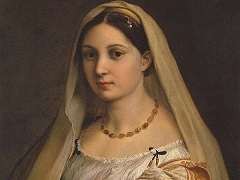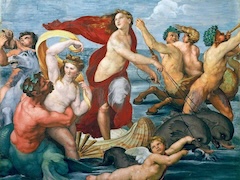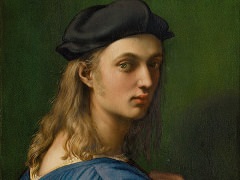La Velata - by Raphael

Responding to The Mona Lisa by Leonardo da Vinci Raphael developed in this portrait his own idea of female beauty and deportment. Art historians have variously identified this beautiful woman as a patron's bride and as the artist's lover and muse; she appears as a model in many of Raphael's most important works.
La Velata shows greater attention to colour and to the rendering of skin and clothes in respect to previous female portraits. The regular oval of the young woman's face stands out against the dark background and her eyes hold an intense and penetrating look. The silk of her sleeves contrasts with her ivory-like skin, and is closely associated with the thin pleating of the dress, held up by a corset with golden embroidery. The artistic conception is related to The Sistine Madonna, especially in the quality of the expression and in the pictorial treatment of the head. The tight modeling of his earlier portraits, including those done in Rome, has given way to a more simplified and generalized approach, one based upon a greater inherent understanding of the forms rather than intensified detailed study. Thus Raphael approaches a solution collateral to that of the great Venetians Giorgione and Titian. His superior control over drawing, however, is never entirely subordinated to painterly qualities. The massive sleeve of the sitter's dress is set on the front plane, where it becomes a nearly independent motive as a passage of pure still-life painting and is another connection to Venetian practice.
















